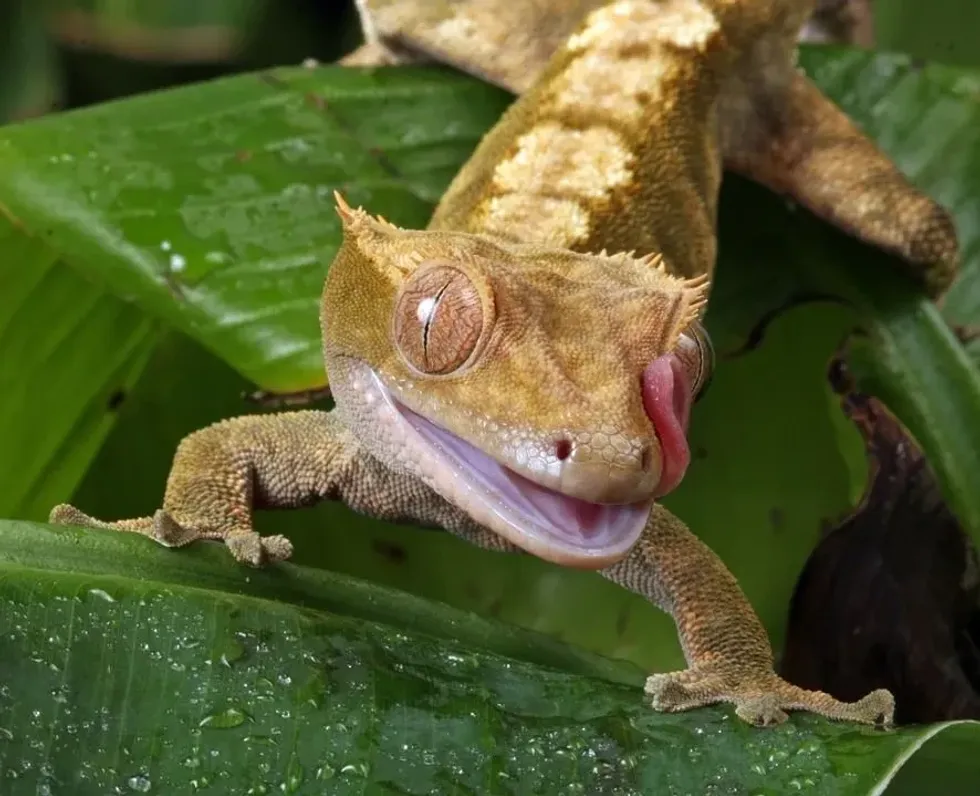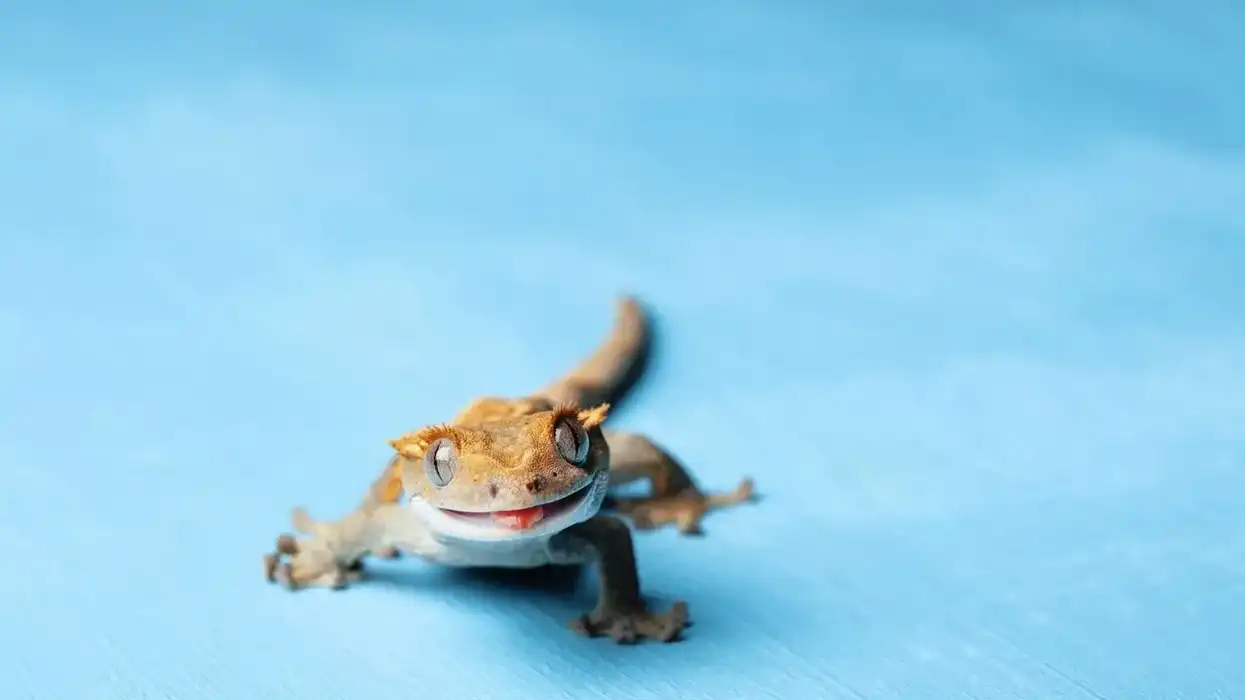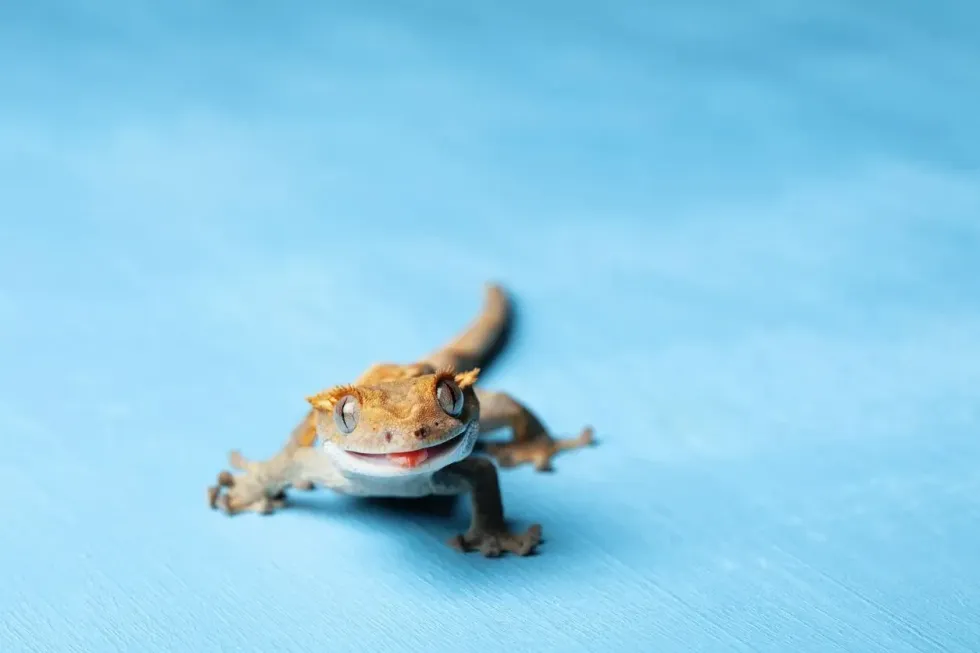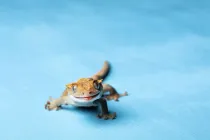Fun Crested Gecko Facts For Kids

Content
- What type of animal is a Crested Gecko?
- What class of animal does a Crested Gecko belong to?
- How many Crested Geckos are there in the world?
- Where does a Crested Gecko live?
- What is a Crested Gecko's habitat?
- Who do Crested Geckos live with?
- How long does a Crested Gecko live?
- How do they reproduce?
- What is their conservation status?
- What do Crested Geckos look like?
- How cute are they?
- How do they communicate?
- How big is a Crested Gecko?
- How fast can a Crested Gecko move?
- How much does a Crested Gecko weigh?
- What are their male and female names of the species?
- What would you call a baby Crested Gecko?
- What do they eat?
- Are they poisonous?
- Would they make a good pet?
- Did you know...
- Unique features of the Crested Gecko
- Having your own Crested Gecko
If you are an animal lover and absolutely adore lizards and other various reptiles then you will surely not get disappointed with this article. The Crested Gecko is one such animal that can be the perfect pet for you.
These animals are endemic species and are distributed all over the world. Despite the animal being listed as Vulnerable, Crested Geckos come in handy in being the perfect pet.
These are easy-going animals and they bond with their owners very well within a short span of time. Since they are natives of the tropical rainforests, proper care must be taken to build an exact environment in their enclosures.
Humidity plays a vital role in the health and care of these animals. Crested Geckos should be fed three times a week and a proper check must be done on them to see if they shed properly or not.
You will also learn a lot about Crested gecko care and Eyelash Crested Gecko facts for kids. If you find our article informative do check on coral snake and African fat-tailed gecko facts too.
Crested Gecko Interesting Facts
What type of animal is a Crested Gecko?
The Crested Gecko aka Eyelash Gecko belongs to the family of Diplodactylidae.
What class of animal does a Crested Gecko belong to?
The Crested Gecko belongs to the family of Reptilia of the Animalia kingdom.
How many Crested Geckos are there in the world?
There is no substantial data or statistics that account for how many Crested Geckos are there presently in the world.
However, it must be noted that since these tiny reptiles are classified under Vulnerable by the International Union for Conservation of Nature or IUCN Red List, their numbers are constantly on the decline and have been for the last few decades.
The main reason for their decline in number is due to habitat loss which occurs due to human activities like deforestation and was thought to be extinct.
These Crested Geckos were believed to an extinct species until a tropical storm in 1994 rediscovered them.
Where does a Crested Gecko live?
The Crested Geckos live in the tropical rainforests. They are endemic species i.e.
they belong to a particular country and are exclusive to that nation. These species are natives of New Caledonia and are found in the Isle of Pines and in the Grand Terre. It is also assumed that Crested Geckos has spread to a neighboring Kotomo Island, but the claims are yet to proven by researchers and scientists.
What is a Crested Gecko's habitat?
There are three different populations of this species of the Crested Gecko which is found in New Caledonia. Two of this population inhabits the island of Grand Terre while the last disjunct population can be found in the Isle of Pines.
These islands are filled with hills and that is the perfect habitat for these wild reptiles.
The place lies in the tropical rainforest which receives heavy rainfall throughout the year. The flora and fauna which grow in this habitat play a vital role in the survival of the Crested Geckos.
These animals prefer a colder type of climate and can live comfortably in climatic conditions where the temperature ranges from 51.8-75 F. These animals prefer staying in elevated conditions about 492-3281 ft above sea level.
These animals can be seen staying near the base of the trees during the day where it is calm and shady and at night they can be found looking for food in various shrubs and hedges. Humidity plays a vital role in the health and care of these animals.
Who do Crested Geckos live with?
The Crested Geckos don't stay in groups or in packs and prefer being alone. Thus they can be considered solitary animals.
These animals love hiding from the sight of other animals they usually search or hunt for food during the night. Though they are slow in speed they can jump pretty well. They are extremely agile and can be termed as semi-arboreal animals i.e they are expert tree climbers and can jump from one tree canopy to another.
How long does a Crested Gecko live?
The Crested Gecko has an uneven lifespan out in the wild as they live in constant fear from predators or from other sources. Thus there is no concrete data that properly certifies the lifespan of these tiny reptiles in the wild.
However, when kept in captivity like in protected areas or zoos these animals can live up to 10-20 years.
How do they reproduce?
The mating process which the Crested Gecko depicts is unrecorded and unobserved in the wild forest conditions.
However, the mating process of the Crested Gecko is properly recorded when these animals are kept in captivity. It is seen that the males of these species are extremely aggressive during the mating season and they are known to fight amongst themselves when they come in contact with one another.
As a result, during the breeding period, numerous females are kept with a single male as a result their mating process is polygamous in nature.
As for the mating rituals the male showcases shaky movements to which a willing female responds. Sexual maturity among these animals is different for the males and female variants.
The females mature at an age of 12 months while in the case of males it is a bit earlier and ranges from an age of around 9-12 months.
The males also undergo a physical dimorphism which separates them from the females and becomes an easy way to identify a male from that of a female. The males develop a bulge in their tails.
The average clutch size of the Crested Geckos is two eggs which they usually a month after mating.
They also lay two eggs after every four to six weeks as they have the special ability to retain the sperm inside their body. These animals usually lay eggs 8-10 times in a year and if there is a slight drop in temperature of the surrounding it can hugely affect the eggs and thereby affect the unborn baby gecko.
The eggs are usually laid in holes on the ground which serves as a shelter and provides protection from predators.
The parents take up no additional responsibility for parental care after the eggs are hatched and carry on with their lives. The young ones hatch on their own and like other animals, they start taking care of themselves after birth.
What is their conservation status?
According to the International Union for Conservation of Nature or the IUCN Red List, the Crested Geckos are listed in the Vulnerable category. The population of these animals has been constantly on the decline due to predators and humans.
The impact which rodents have on these animals is pretty high, as these small slow-moving reptiles are easy to target of these rodents.
The little fire ant which is also present in their habitat also poses a huge threat to the population of the Crested geckos.
These ants attack, sting and prey on the geckos in large numbers and also acts as a direct rival in the food of the Crested geckos. As for human activities, deforestation, habitat loss, lowering of the elevated lands are the major threats which the Crested Geckos face in the jungles.
Their number started declining at a steady rate and was thought to be extinct. However, a tropical storm in the year 1994 accidentally rediscovered these animals and since then they are listed in the Vulnerable category with proper measures being implemented so they don't become extinct again.
Last but not the least, these animals are also exported from their native habitat despite being endemic animals by illegal traffickers.
Crested Gecko Fun Facts
What do Crested Geckos look like?
The animals are easily identifiable from other animals of its family owing to the distinctive features which the Crested Gecko has. These animals usually have big eyes accompanied by a large head that is almost triangular in shape.
Soft and large scales are found all over their body which can be of a variety of colors like reddish-brown or tan in color.
The scales that are present on the body can often depict the shape of a granule.
They have long and slender prehensile tails which act as a grabbing tool when these semi-arboreal reptiles jump from a tree canopy to another. Beside their eyes, they have two big ears.
Three different types of Crested Gecko morphs are found in these animals which are distinct from one another in terms of shape and color. Those are the white-fringed morph, tiger morph, and patternless morph.
The geckos which have the white-fringed morph usually have yellowish-white color all over their body including their chest.
The ones that are devoid of any patterns i.e the patternless ones are found to be in a single solid color variant.
The color for patternless morph ranges from gray, red, yellow, green, and other similar vibrant colors. As for the ones that have the tiger morph on their body, these variants can be seen with a lightly colored body with dark and bright stripes and patterns all over their body thereby giving them the look exactly similar to a tiger.
Apart from these three major patterns, other numerous variations in color and morphs are found in the wild Crested Geckos. Being semi-arboreal animals, these animals jump from one tree to another in look for insects and food and also to escape from deadly predators.
These animals have the added benefit of having a prehensile tail accompanied with adhesive pads on their feet which helps them effective tree climbing and jumping.

How cute are they?
While few people are afraid of reptiles like geckos, others find these tiny animals to be extremely adorable.
How do they communicate?
Like other animals, the Crested Gecko uses vocal sounds and body language based on their behavior for their effective means of communication.
Be it to escape a predatory by frightening the opponent to call for a mate during the breeding season, these reptiles use a high-pitched sound which is usually in chirps.
When it comes to their body language, the Crested Gecko usually stands tall on its hind legs, pushes its body in a forward way thereby showcasing that the animal feels threatened or can sense the presence of a predator.
These animals also have large eyes which helps them to see things clearly when it's dark or when they go on a hunt at night.
The eyes of these particular animals are different from the one of its family. They have vertical pupils which are bulged around the edges.
These special eyes allow the Crested Gecko to absorb a huge amount of light in their pupils and thereby allowing them to see clearly in the dark.
How big is a Crested Gecko?
The Crested Geckos aka Correlophus ciliatus are relatively tiny animals and thus, as a result, they are considered small-sized reptiles. Normally adult Crested Geckos have an average length of around 8 in or 20.3 cm approximately.
If the snout to vent length of the Crested Gecko is considered then it lies in the range of 4-4.7 in or 10.2-11.9 cm roughly. In comparison to adult black rats, these reptiles are half their size as an average size black rat attains a size of around 12.5-18 in or 32-46 cm.
How fast can a Crested Gecko move?
The Crested Geckos are slow movers but they are highly agile. Their agility comes from them being excellent jumpers.
If an adequate amount of space is provided to these animals then they are going to have a gala time. They would jump all around the place in their merry mood. They also have a strange way of movement as they tend to stop while moving.
They would stop, wait and observe the surroundings and then go again and this process continues on and on. This particular pattern of movement is observed in the Crested Geckos everywhere, be it on a branch of a tree or on the ground.
How much does a Crested Gecko weigh?
Owing to the fact that these animals are pretty small in size, their weight depicts the same. These tiny reptiles are very light and they weigh roughly around 1.1-1.2 oz or 30-35 g.
What are their male and female names of the species?
Like the majority of the reptiles, there is no specific name or names that have been assorted to both male and female Crested Gecko.
What would you call a baby Crested Gecko?
Similar to animals that hatch from eggs, a baby gecko is referred to as a hatchling. So in the case of a Crested Gecko, the appropriate way to define a baby Crested Gecko would be to refer to it as a Crested Gecko hatchling.
What do they eat?
Like all the animals under their family, the Crested Geckos are omnivorous animals in nature. They hunt on small insects in the forests and apart from that they also feed exclusively on fruits, nectar. These animals are nocturnal and thus they usually come out and hunt at night.
If you own a Crested Gecko make sure to feed it with vital and essential minerals like Calcium and Vitamin D3 which ensures the right growth and development of these reptiles. Many wild Crested Geckos perish from diseases and mineral deficiency which are not found in the wild New Caledonian jungles.
Are they poisonous?
No, the Crested Gecko is not at all poisonous in nature. These animals are extremely shy and generally, stay away from the sight of other large animals.
Until and unless these animals feel threatened they don't bite anyone. Despite having numerous teeth, the bite of a Crested Gecko is harmless. The bite will not even break the skin where it was bitten and neither it has any toxins, thus the bites are completely harmless and these animals are non-venomous.
Would they make a good pet?
Yes, the Crested Gecko and the Eyelash Geckos will make very good pets. These animals are not harmful and their temperance is relatively calm.
They are peace-loving creatures who are always on the run to jump on new spots. Handling these reptiles is pretty easy.
These animals are docile, so for holding these animals, patience is required. Once it gets accustomed to your touch it will not fear you. On average, you can hold your pet for roughly around 15 minutes.
However, do remember that since they are a type of lizards, so always refrain from kissing them. These animals are considered Vulnerable by the IUCN, so it is advised to not keep them as pets, rather they should be kept in prevention centers where they will be given utmost proper care day in and day out.
Did you know...
While naming this particular animal, originally its scientific name was given as Correlophus ciliatus. However, after some time the Crested Gecko was renamed to its synonymous Rhacodactylus ciliatus. Again after much research and with a wider branching of the taxonomy and Reptilia class, the name shifted back to its original one.
When a Crested Gecko is cornered it drops its tail to distract the predator like any lizard. However, the tail does grow back with time.
Unique features of the Crested Gecko
The new hatchlings, i.e. the young geckos refrain from eating anything for a period of three to five days.
They survive on the yolk of the egg until and unless they shed their skins for the very first time of their life. This gecko licks their eyes to keep them moist and clean from any kinds of impurities.
While having them as pets you must always ensure that you provide them the exact climatic conditions which they used to get in the tropical forests.
If proper humidity, that of a tropical rainforest, is not provided the lizard will have trouble shedding its skin. The best way to identify if a Crested Gecko is healthy and devoid of any diseases is to ensure that it sheds its skin regularly.
Having your own Crested Gecko
If you are planning to own a Crested Gecko for yourself then it can be a great choice as they make excellent pets. The price of the Crested Gecko lies in the range of $40-$100 USD.
Try to fit these animals in a large tank where there is an abundance of space for them to jump around and can also be fed with traditional Crested gecko food three times a week. The males are extremely aggressive when it comes to territorial boundaries.
So it is advised to keep one male in a tank. However, you can keep two or more female geckos along with the male variant.
The tank should be filled with branches, twigs of different plants and animals to make it adjustable to their habitat. Not much source of light is required as they are nocturnal animals.
However, 60-80% humidity must be maintained for the survival and proper health of these animals. If Crested Geckos are put under continuous stress, they resolve to avoid eating and thus dies easily.
Here at Kidadl, we have carefully created lots of interesting family-friendly animal facts for everyone to discover! Learn more about some other reptiles including sand lizard, or bog turtle.
You can even occupy yourself at home by drawing one on our crested gecko coloring pages.
We Want Your Photos!
More for You
Bachelor of Arts specializing in Journalism and Mass Communication, Postgraduate Diploma in Sports Management

Moumita DuttaBachelor of Arts specializing in Journalism and Mass Communication, Postgraduate Diploma in Sports Management
A content writer and editor with a passion for sports, Moumita has honed her skills in producing compelling match reports and stories about sporting heroes. She holds a degree in Journalism and Mass Communication from the Indian Institute of Social Welfare and Business Management, Calcutta University, alongside a postgraduate diploma in Sports Management.
Bachelor of Law

Abdulqudus MojeedBachelor of Law
A versatile professional with a passion for creative writing and technology. Abdulqudus is currently pursuing his Bachelor of Law from the University of Lagos and has experience as a tutor, intern assistant, and volunteer. He possesses strong organizational skills and is a detail-oriented person.
Disclaimer
1) Kidadl is independent and to make our service free to you the reader we are supported by advertising. We hope you love our recommendations for products and services! What we suggest is selected independently by the Kidadl team. If you purchase using the Buy Now button we may earn a small commission. This does not influence our choices. Prices are correct and items are available at the time the article was published but we cannot guarantee that on the time of reading. Please note that Kidadl is a participant in the Amazon Services LLC Associates Program, an affiliate advertising program designed to provide a means for sites to earn advertising fees by advertising and linking to Amazon. We also link to other websites, but are not responsible for their content.
2) At Kidadl, we strive to recommend the very best activities and events. We will always aim to give you accurate information at the date of publication - however, information does change, so it’s important you do your own research, double-check and make the decision that is right for your family. We recognise that not all activities and ideas are appropriate for all children and families or in all circumstances. Our recommended activities are based on age but these are a guide. We recommend that these ideas are used as inspiration, that ideas are undertaken with appropriate adult supervision, and that each adult uses their own discretion and knowledge of their children to consider the safety and suitability. Kidadl cannot accept liability for the execution of these ideas, and parental supervision is advised at all times, as safety is paramount. Anyone using the information provided by Kidadl does so at their own risk and we can not accept liability if things go wrong.
3) Because we are an educational resource, we have quotes and facts about a range of historical and modern figures. We do not endorse the actions of or rhetoric of all the people included in these collections, but we think they are important for growing minds to learn about under the guidance of parents or guardians.







